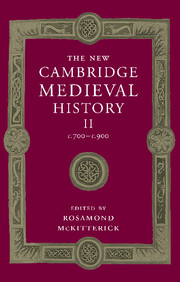Crossref Citations
This Book has been
cited by the following publications. This list is generated based on data provided by Crossref.
Abulafia, David
1996.
Islam in the History of Early Europe.
Itinerario,
Vol. 20,
Issue. 3,
p.
9.
Abulafia, David
1997.
Islam in the history of early Europe.
European Review,
Vol. 5,
Issue. 03,
p.
241.
Collins, Roger
1999.
Early Medieval Europe 300–1000.
p.
262.
Gretsch, Mechthild
2000.
The Junius Psalter gloss: its historical and cultural context.
Anglo-Saxon England,
Vol. 29,
Issue. ,
p.
85.
Verhulst, Adriaan
2002.
The Carolingian Economy.
Scarfe Beckett, Katharine
2003.
Anglo-Saxon Perceptions of the Islamic World.
Melve, Leidulf
2003.
Literacy --Aurality --Orality A Survey of Recent Research into the Orality/Literacy Complex of the Latin Middle Ages (600-1500).
Symbolae Osloenses,
Vol. 78,
Issue. 1,
p.
143.
MacLean, Simon
2003.
Kingship and Politics in the Late Ninth Century.
Merrills, A. H.
2005.
History and Geography in Late Antiquity.
Wood, Jamie
2006.
Elites and Baptism: Religious ‘Strategies of Distinction’ in Visigothic Spain.
Studies in Church History,
Vol. 42,
Issue. ,
p.
3.
Lieberman, Victor
2008.
Protected Rimlands and Exposed Zones: Reconfiguring Premodern Eurasia.
Comparative Studies in Society and History,
Vol. 50,
Issue. 3,
p.
692.
Hummer, Hans
2009.
A Companion to the Medieval World.
p.
36.
Frampton, Michael
2010.
Encyclopedia of Life Sciences.
Becher, Matthias
2011.
The Roman Empire in Context.
p.
177.
Couser, Jonathan
2012.
“Let Them Make Him Duke to Rule that People”: TheLaw of the Bavariansand Regime Change in Early Medieval Europe.
Law and History Review,
Vol. 30,
Issue. 3,
p.
865.
MacLean, Simon
2013.
History and politics in late Carolingian and Ottonian Europe.
Frampton, Michael
2015.
Encyclopedia of Life Sciences.
p.
1.
Costen, Michael D
and
Costen, Nicholas P
2016.
Trade and Exchange in Anglo-Saxon Wessex, cad600–780.
Medieval Archaeology,
Vol. 60,
Issue. 1,
p.
1.
Castro, Obdulia
2017.
Rerouting Galician Studies.
p.
205.
Di Cosmo, Nicola
and
Maas, Michael
2018.
Empires and Exchanges in Eurasian Late Antiquity.



